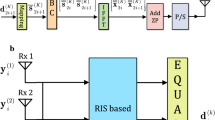Abstract
In code division multiple access channels multiuser detection techniques are known to be effective strategies to counter the presence of multiuser interference towards improving spectral efficiency. Generally, multiuser detectors can provide excellent performance only when the signature waveforms of all users are precisely known. Hence, the estimation of signature waveforms is a challenging issue in mobile communication systems. In this paper, we compare the performance of two short training sequence aided signature waveform estimators. One is maximum likelihood type signature waveform estimator that requires the knowledge of spreading sequences and short training sequences. The other estimator is recently proposed based on subspace method and requires the knowledge of training sequences only. Through the simulations, we show the signature waveform estimation performance of both systems and the effect of the estimation error on the performance of a multiuser detector. The complexity comparisons of both systems are also given.
Similar content being viewed by others
References
S. Haykin, Adaptive Filter Theory, Englewood Cliffs, NJ: Prentice-Hall, 2nd edn., 1991.
X. Wang and H.V. Poor, “Blind Equalization and Multiuser Detection in Dispersive CDMA Channels”, IEEE Trans. on Communication, Vol. 46, No. 1, pp. 91–103, 1998.
H. Liy and G. Xu., “A Subspace Method for Signature Waveform Estimation in Synchronous CDMA Systems”, IEEE Trans. on Communication, Vol. 44, No. 10, pp. 1346–1354, 1996.
A. Rizaner, H.A. Amca, K. Hacioğlu, and A.H. Ulusoy, “Channel Estimation Using Short Training Sequences”, in IEEE VTS Fall VTC2000 52nd Vehicular Technology Conference, VTC'2000, Boston, USA, pp. 2630–2633, September 2000.
Y. Zhang, G. Bi, and B.P. Ng, “Subspace Training Method for Multiuser Detection in Dispersive CDMA Channel”, IEE Electronics Letters, Vol. 36, No. 15, pp. 1315–1317, 2000.
J.G. Proakis, Digital Communications, McGraw Hill, New York, 3rd edn., 1995.
W.C. Lee, “Overwiev of Cellular CDMA”, IEEE Trans. Veh. Technol., Vol. 40, No. 2, pp. 291–301, May 1991.
G.H. Golub and C.F. Van Loan, Matrix Computations, Johns Hopkins University Press, Baltimore, Maryland, 1983.
M. Honig and K.K. Tsatsanis, “Adaptive Techniques for Multiuser CDMA Receivers”, IEEE Signal Proc. Magazine, pp. 49–61, May 2000.
D.V. Sarwate and M.B. Pursley, “Crosscorrelation Properties of Pseudorandom and Related Sequences”, Proc. of IEEE, Vol. 68, No. 5, pp. 593–619, 1980.
A.H. Ulusoy, A. Rizaner, H. Amca, and K. Hacioğlu, “The Adaptive Path Selective Decorrelating Detector: Performance Analysis with Channel Estimation Errors”, Signal Processing, Vol. 84, No. 10, pp. 1909–1917, Oct. 2004.
Author information
Authors and Affiliations
Corresponding author
Additional information
We use the term “signature waveform” to refer to the convolution of the channel and the spreading code throughout the paper.
Hasan AMCA was born in 1961 in Nicosia-Cyprus. He graduated from the Higher Technological Institute in Magosa – Cyprus (which is renamed later as Eastern Mediterranean University). He joined EMU in 1985 after receiving a M.Sc. (Digital Signal Processing) degree from the University of Essex in England (1985). He took his Ph.D. (Mobile Communications) from the University of Bradford where he was on a Commonwealth scholarship. He has been teaching in the Electrical and Electronic Engineering Department of Eastern Mediterranean University since 1993 where he also served as the Vice Chairman from Spring 1998 to Spring 2000. He has been appointed as the Director of the School of Computing and Technology of the EMU since Spring 2000. His research interests include Multi User Detection of CDMA signals, Adaptive Equalisation, Multi Carrier Systems, Mobile Radio Systems and Networks, Internet and Information Technology Applications in Education.
Ahmet Rizaner was born in Larnaca, Cyprus, on January 31, 1974. He received the B.S. and M.S. degrees in Electrical and Electronics Engineering from the Eastern Mediterranean University, Famagusta, North Cyprus, in 1996 and 1998, respectively. He completed his PhD. degree in Electrical and Electronic Engineering in Eastern Mediterranean University and joined Eastern Mediterranean University as a lecturer in 2004. He is lecturing in the School of Computing and Technology. His main research interests include CDMA communications, adaptive channel estimation, and multiuser detection technique.
Kadri Hacioğlu was born in Nicosia, Cyprus. He received the B.Sc., M.Sc., and Ph.D. degrees in electrical and electronic engineering from the Middle East Technical University, Ankara, Turkey, in 1980, 1984, and 1990, respectively. After his two-year military service, in 1992, he joined the faculty of Eastern Mediterranean University, Magosa, North Cyprus, as an Assistant Professor, and became an Associate Professor in 1997. While there, he taught several classes on electronics, digital communications, speech processing and neural networks. During this time, he conducted research on applying fuzzy logic, neural networks, and genetic algorithms to signal processing and communications problems. From 1998 to 2000, he was a Visiting Professor in the Department of Computer Science, University of Colorado, Boulder. Here, he taught classes on neural networks and continued his research. Since 2000, he has been a Research Associate at the Center for Spoken Language Research, University of Colorado. He has authored or coauthored numerous papers and supervised a dozen M.Sc./Ph.D. theses. His current research interests are concept-based language modeling, speech understanding, natural language generation, and search methods in speech recognition/understanding. He also does research on multiuser detection and equalization in CDMA systems.
Ali Hakan Ulusoy was born in Eskişehir, Turkey, on June 3, 1974. He graduated from the double major program of the department of Electrical and Electronic Engineering and department of Physics in Eastern Mediterranean University as the first rank student of Faculty of Engineering in 1996. He received his M.S. degree in Electrical and Electronic Engineering in Eastern Mediterranean University in 1998. He completed his Ph.D. degree in Electrical and Electronic Engineering in Eastern Mediterranean University and joined Eastern Mediterranean University as a lecturer in 2004. He is lecturing in the School of Computing and Technology. His current research interests include receiver design, multi-user detection techniques, blind and trained channel estimation in Code Division Multiple Access (CDMA).
Rights and permissions
About this article
Cite this article
Amca, H., Rizaner, A., Hacioğlu, K. et al. Training Sequence Aided Signature Waveform Estimation. Wireless Pers Commun 36, 45–57 (2006). https://doi.org/10.1007/s11277-006-7533-3
Issue Date:
DOI: https://doi.org/10.1007/s11277-006-7533-3




